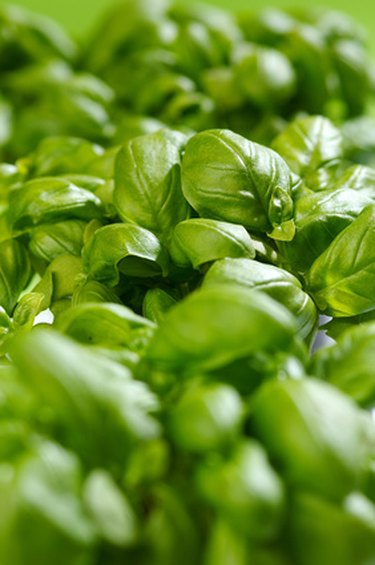
While the name "mint" may bring to mind the flavors of biting peppermint or refreshing spearmint, mint plants encompass a wide range of popular culinary herbs. The Lamiaceae family, also known as labiatae, is also known popularly as the mint family. It contains over 200 genera and 3,200 individual species.
Basil
Video of the Day
Basil (Ocimum basilicum) is one of the culinary herbs of the mint family; in addition to its use in cookery, it may be added as an essential oil to fragrances and cleansers, such as shampoos and soaps. Basil leaves may be used either fresh or dried in a range of Mediterranean cuisines and to season dishes ranging from stews to salads. Several varietals of basil exist, including sweet basil, purple-colored basil, lemon-scented basil, anise and licorice.
Video of the Day
Lavender
Another highly aromatic member of the mint family, the lavender plant's flowers are frequently used as perfumes. Lavender (Lavandula angustifolia, or Lavandula officinalis) is commonly added to soaps and shampoos in essential oil form, or dried and wrapped into sachets to freshen rooms or closets. Inhalation of its aroma has even been tied to medical uses, including relief from anxiety, insomnia and fatigue. Lavender grows throughout the Mediterranean countries, its native habitat, as well as throughout Europe, Australia and the U.S. Generally it grows to heights of around 24 inches with flowers growing in densely packed clusters.
Rosemary
Rosemary (Rosmarinus officinalis) is yet another of the popular cooking herbs that belongs to the mint family. Its intense aroma also makes it a common fragrance for soaps, shampoos and cosmetics. Rosemary also has traditional medicinal uses, including stimulation of hair growth and menstrual flow and relief of indigestion. Scientists have also identified a high-antioxident level in rosemary. Rosemary plants are originally from the Mediterranean, though they thrive in a wide range of warm, sunny environments. A rosemary plant may reach up to 6 feet high, with dark green needles and pale blue flowers. The name rosemary comes from the Latin "rosmarinus," meaning sea dew.
Mint
Naturally, the mint plant also belongs to the larger mint family. There are several common varieties, including peppermint (Mentha piperita) and spearmint (Mentha apicata). The leaves of the plant are commonly used for cooking both sweet and savory dishes and for brewing tea. Peppermint has characteristically reddish stems and lavender flowers, whereas spearmint's leaves are lighter green, as is its stalk, and its flowers are pink instead of lavender. Mint plants may reach heights of up to 2 feet. While they are easy to grow, some gardeners prefer not to plant mint because it can be so invasive.
- USDA Department of Conservation of Natural Resources: Classification for Kingdom Plantae Down to Family Lamiaceae
- Purdue University Center for New Crops and Plants Products: Basil
- University of Maryland Medical Center: Lavender
- University of Maryland Medical Center: Rosemary
- University of Illinois Extension: Herb Gardening: Mint